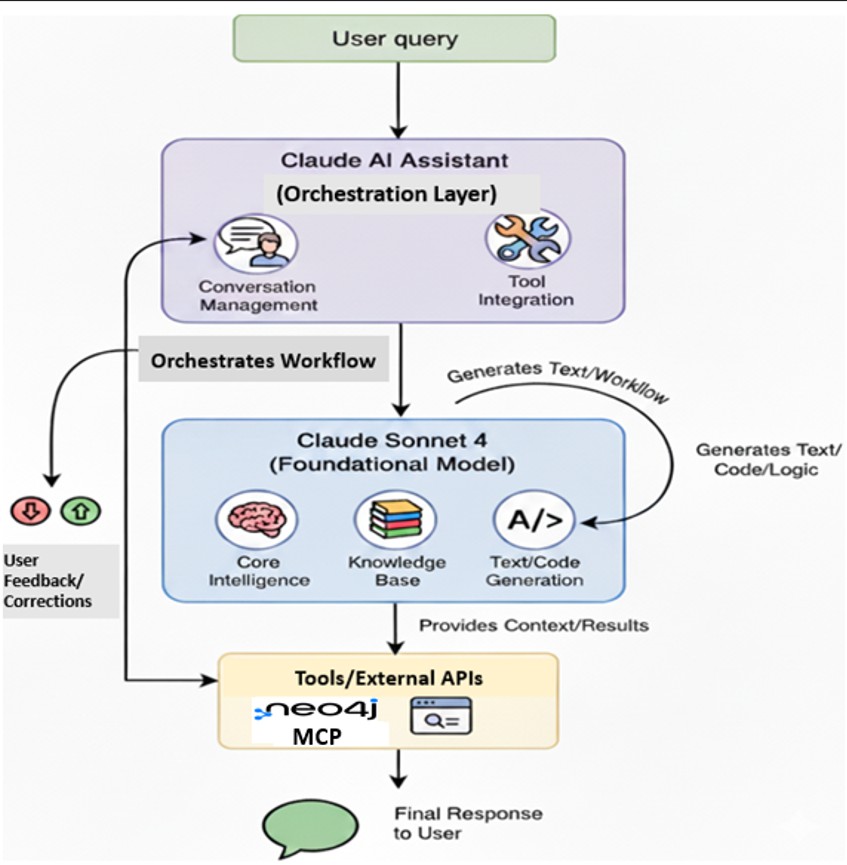Introduction
I teamed up with my ex-colleague from S&P Global, Simon Chen who is the co-founder and general manager at segmentedsupplychain.com and a member of various expert networks. Our goal was to explore how AI can be applied to a very specific, complex domain: analyzing the largest publicly traded private equity firms. He examined the industry’s reporting and performance, uncovering surprising insights. You can read his analysis here: Segmenting Private Equity Firms: A Test for Claude.
We chose Claude AI and Neo4j for this project because together they unlock a new way of working with data. Claude’s foundational models excel in coding, long-context reasoning, and safe, professional use cases. Neo4j provides a flexible knowledge graph database that brings structure, context, and relational depth to complex datasets.
Why Knowledge Graphs?
Knowledge graphs provide several advantages for deeper data insights:
- Breaking Down Silos: They integrate data from multiple sources into a unified view, linking what would otherwise remain isolated.
- Contextual Understanding: They map relationships between entities, letting you analyze not just what happened, but also the why and how.
- Complex Querying: Graph traversal makes it easy to discover insights that would be difficult with relational databases.
- Grounding AI: For generative models like Claude, a knowledge graph acts as a source of real-world truth. This reduces reliance on internal training data alone, improving accuracy and trustworthiness.
The Architecture
The Claude AI system operates with two tightly connected layers:
- Claude Sonnet 4 (Foundational Model) – The reasoning engine. It understands language, generates Cypher queries, writes code, and applies data visualization principles.
- Claude AI Assistant (Orchestration Layer) – The coordinator. It manages conversation flow, integrates tools like the Neo4j MCP server, and executes workflows end-to-end.
How They Work Together: A Practical Example
When we ask: “Create a stacked bar chart from my Neo4j data.”
When we ask: “Create a stacked bar chart from my Neo4j data.”
- Orchestration Layer interprets the request, plans the workflow (schema discovery → query → visualization), and calls the Neo4j MCP server for data.
- Foundational Model generates the Cypher query, retrieves the results, and writes the JavaScript/React code for the chart. It also reasons about the best way to represent the data visually.
- Orchestration Layer collects the data and code, assembles the chart, and returns the final visualization with a natural language explanation.
This division of responsibilities makes the system powerful: the orchestration layer manages logistics and integration, while the foundational model focuses on reasoning and content generation.
The Role of Feedback
The workflow doesn’t stop once a chart is produced. User feedback is central:
- Correction in Context – If the output is wrong, the assistant incorporates corrections into the ongoing session.
- Adaptive Workflows – This lets Claude adjust its next steps, for example by modifying a calculation or query logic.
While the model doesn’t permanently retrain from interactions, this feedback loop ensures more accurate and relevant results within each engagement.
Conclusion
Bringing together Claude AI and Neo4j’s MCP server illustrates the real potential of modern AI when it’s grounded in structured, contextual data. By separating orchestration and reasoning, we can tackle complex datasets, generate meaningful visualizations, and uncover insights that would otherwise remain hidden.
Bringing together Claude AI and Neo4j’s MCP server illustrates the real potential of modern AI when it’s grounded in structured, contextual data. By separating orchestration and reasoning, we can tackle complex datasets, generate meaningful visualizations, and uncover insights that would otherwise remain hidden.
This project underscores a broader lesson: AI is most powerful when it works hand-in-hand with rich, well-organized data and clear business objectives. As AI continues to evolve, the organizations that will truly benefit are those that combine technological innovation with thoughtful data strategy.
